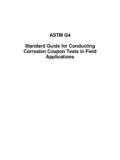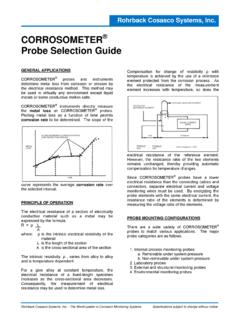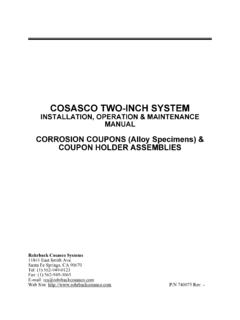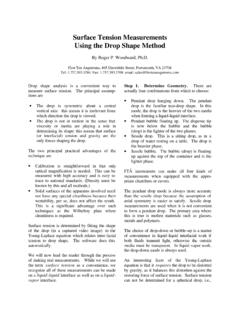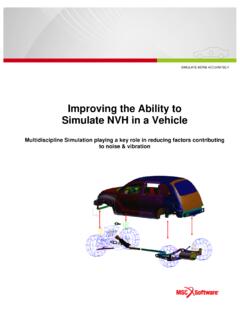Transcription of INJECTION & SAMPLING SYSTEM - Cosasco
1 Cosasco TWO-INCH SYSTEM INSTALLATION, OPERATION & MAINTENANCE MANUAL INJECTION & SAMPLING SYSTEM Rohrback Cosasco Systems 11841 East Smith Ave. Santa Fe Springs, CA 90670 Tel: (1) 562-949-0123 Fax: (1) 562-949-3065 E-mail: Web Site: P/N: 740076 Rev. - Table of Contents Chapter 1 Chapter 2 Chapter 3 SAMPLING Considerations ..3 Chapter 4 INJECTION Chapter 5 INJECTION and/or SAMPLING SYSTEM Chapter 6 Field Operation of the INJECTION and/or SAMPLING 1 Chapter 1 Introduction During the installation/construction stages of the Cosasco INJECTION and/or SAMPLING Systems, the following Manuals are recommended: 600000-MANUAL RBS/RBSA Retriever and Service Valve 740074 Trepanning, Positioning and Welding 740078 Hot Tap The Cosasco INJECTION SYSTEM and SAMPLING SYSTEM share many interchangeable parts.
2 The INJECTION SYSTEM relies on an externally supplied pressure differential which is greater than the pipeline or vessel operating pressure. The SAMPLING SYSTEM is in effect a reversal of the principles involved in the INJECTION SYSTEM in that the external pressure is atmospheric and lower than that of the pipeline or vessel pressure. Both Systems can be operated on pipelines or vessels already on stream and under full SYSTEM operating pressures. However, by utilizing the Cosasco Hot Tap (Manual 740078), in conjunction with the Cosasco Retriever and Service Valve tandem hook-up (Manual 600000-MANUAL) either SYSTEM can be added at a later date even when it is impractical to shut a SYSTEM down. This same hook-up can also be used in inserting or retrieving the many other Cosasco corrosion monitoring or prevention devices while units are under full operating pressures.
3 2 Chapter 2 General Internal corrosion in product pipelines or vessels, in most cases, is caused by water and oxygen dissolved in the product. The water, in contact with oxygen, corrodes steel. If corrosion is not controlled, many forms of physical deterioration can result. There would also be contamination of the product with rust particles and other precipitates. In a basic sense, corrosion occurs by one of two processes. One is by the exposure of metals with gases at high temperatures and is called dry corrosion. The other, wet corrosion, is caused by the reaction of metals and their environments at normal temperatures, but where the reaction is electrochemical and dependent upon the presence of an electrolyte. Most water is very conducive to wet corrosion due to the complex mixtures of dissolved solids and gases it contains.
4 3 Chapter 3 SAMPLING Considerations SAMPLING is one of the main ways of obtaining an analysis of wet corrosion environments. It is not a prevention measure in itself, but permits analysis for specific testing of oxygen, carbon dioxide and hydrogen sulfide content. It also allows testing for iron, acids, bacteria, organic matter, effluents and solid matter. Whether applied to a gas, oil, or water SYSTEM , SAMPLING can be a very helpful aid in diagnosis both potential corrosion problems and the effectiveness of corrosion prevention measures. The Cosasco SAMPLING SYSTEM allows for the SAMPLING extraction point to be at any position on the pipe OD or on the vessel. To utilize SAMPLING to its maximum, extraction areas should be considered at: 1.
5 The beginning and the end of lines. 2. Pipeline junctions. 3. Low spots in the pipeline. 4. The drain line of three phase separators upstream of water drain or dump valves. 5. Tank or vessel bottoms. 6. The drain lines of desalters. 7. The gas outlets from two phase separators. 8. The gas main to compressors. 9. Immediately prior to chemical INJECTION points. 10. The end of pipelines to test for residual inhibitor. The above suggested sample extraction areas should not be considered as all inclusive nor as absolutes, since each SYSTEM has its own peculiarities and often requires its own special arrangement for SAMPLING . 4 Chapter 4 INJECTION Considerations The Cosasco INJECTION SYSTEM was developed to allow for the INJECTION of various inhibitors to retard the various corrosion mechanisms.
6 The National Association of Corrosion Engineers (NACE) has indicated at least the following mechanisms: 1. Adsorption. Forms an invisible thin film only a few molecules thick on the metal to be protected. 2. Coating. Forms a visible bulky precipitate which coats the metal and protects it from attack. 3. Passive. Causes the metal to corrode in such a way that a combination of adsorption and corrosion product forms a passive layer on the metal to be protected. 4. Favorable environment. Causes conditions in the environment to be more favorable for the formation of protective precipitates. 5. Corrodent removal. Removes the aggressive corrodent from the environment. To use inhibitors effectively, several considerations by the corrosion engineer should be realized. The engineer should: 1.
7 Be able to identify those problems which can be solved by the use of corrosion inhibitors. 2. Consider the economics involved as to whether or not the loss due to corrosion exceeds the cost of the inhibitor and maintenance and operation of the INJECTION SYSTEM . 3. Consider the compatibility of inhibitors and the product flow in order to avoid adverse effects which could occur, such as foaming, decreases in catalytic activity, degradation of another metal, etc. 4. Be able to apply the inhibitor under conditions which will produce the maximum expected corrosion prevention effect. When using an inhibitor it should be remembered that all the natural protection such as iron oxide is removed and a protective film is put on the pipe or vessel surface. If this film is removed by uninhibited products, the surface is very susceptible to the water and oxygen in the product flow and their combination begins the corrosion process immediately.
8 It is very important that the film remain intact so this condition cannot exist. Also, it is important to use the correct amount of inhibitor, since many inhibiting agents can accelerate corrosion, particularly localized attack such as pitting, when present in small concentrations. Too little inhibitor is less desirable than none at all. To avoid this possibility, inhibitors should be added in excess and the concentration checked periodically. When two or Chapter 4 5 more inhibiting substances are added to a corrosive environment, the inhibiting effect is sometimes greater than that which would be achieved by either of the two (or more) substances alone. This is called a synergistic effect. The mechanism of the synergistic effect is not completely understood within the industry.
9 Liquid inhibitors are usually preferred because of the ease with which they can be transported, measured and dispersed. Organic inhibitors rarely have the optimum characteristics of viscosity, freezing or boiling points and are therefore dissolved in an appropriate solvent to achieve the desired properties. It is often desirable to blend the inhibitor with a demulsifier, dispersant, surfactant, antifoaming agent or synergistic agent. Premixing or the dilution of the inhibitor can improve handling and promote a more rapid environment phase contact. Viscous inhibitors can be diluted with a compatible hydrocarbon carrier to decrease viscosity thereby making pumping easier and metering at the pump more accurate. Dilution of the inhibitor is sometimes necessary to achieve a desired low dosage rate; , gallons-per-minute, gallons-per-hour, etc.
10 Inhibitor concentrations are expressed as parts per million (ppm). For liquid inhibitors, volumes are used; for example, gallons of inhibitor per million gallons of product to be inhibited. To obtain the amount of inhibitor required for a given SYSTEM , divide the amount of the product flow to be inhibited by 1,000,000 and multiply by the ppm desired: Q = ____V____ x ppm 1,000,000 Q = Quantity of inhibitor required. V = Volume or amount of product flow to be inhibited. ppm = Concentration of inhibitor in parts per million. 6 Chapter 5 INJECTION and/or SAMPLING SYSTEM Installation (See Figures 1 and 2) A. Installation prior to Hot Tap: First, consult Manual 740074, Trepanning, Positioning and Welding, for proper instructions for the attachment of the Access Fitting body and/or welded end fitting to the pipeline, pressure vessel or tank.
